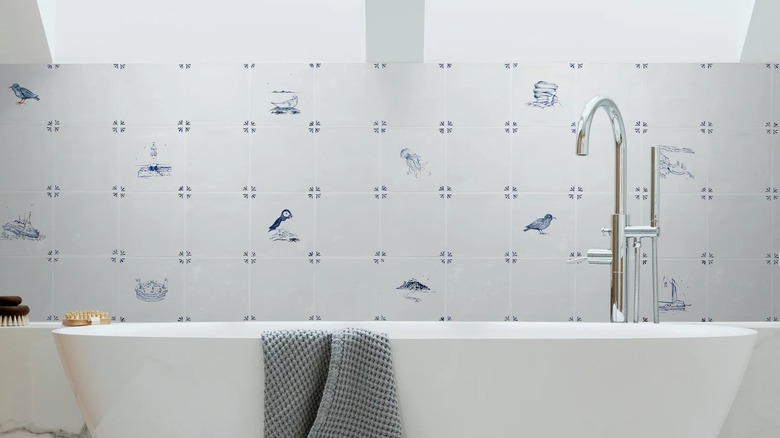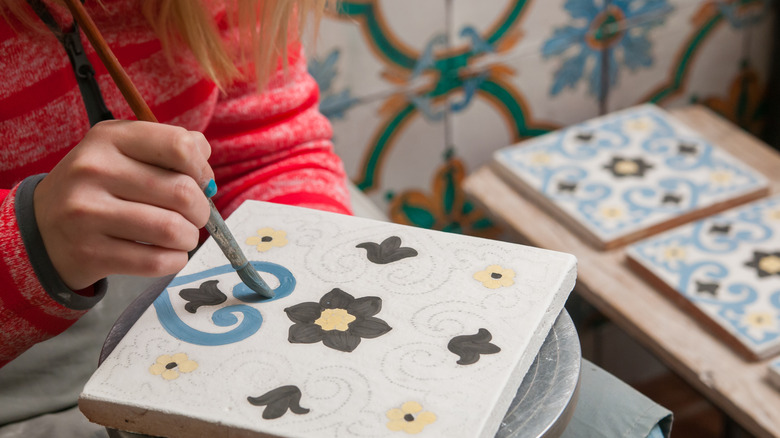The Tile Trend That's Set To Take Over Showers And Bathrooms In 2026
We may receive a commission on purchases made from links.
The white subway tiled minimalist bathrooms of the 2010s have given way to the vibrant, textured extravagance of maximalism in more recent years. Of the many types of tiles you can use in your kitchen and bathroom, hand-painted tiles have become more desirable — though they have a long history that precedes their recent trendiness. Design studios like Nadine Stay are seeing an increased interest in styles like traditional Delft tiles. "The desire for pattern, imperfection, and a sense of history is perhaps why these tiles are especially popular once again," says a post on the Nadine Stay blog.
To take advantage of 2026's emerging trends in your bathroom renovation, consider hand-painted tiles, which have recently regained the popularity they once saw for centuries. The practice of painting decorative ceramic tiles dates to around 4000 BC in Egypt and has spanned cultures from the Assyrians to the Greeks and then the Romans, adorning the mosques and temples of antiquity. Medieval Europeans created scenes with painted ceramic tiles to allow the illiterate to experience Biblical scripture, and in the 17th and 18th centuries, painted Delftware tiles became the latest European — and then American — fashion. Delft tiles, which are handmade in Delft, Holland, are one of the many painted tile styles that have become more popular in modernity, bringing a touch of antique elegance to a home.
The different types of hand-painted tiles for bathrooms
When choosing tile for your shower and bathroom, it's important to keep both style and durability in mind. Though the painted designs on ceramic tile can be intricate and delicate, luckily, the tiles themselves are durable, scratch-resistant, and water-resistant, plus they can be used on walls, floors, and even countertops. The ceramic tiles of the past were not usually very large, but modern options come in large formats spanning up to 48 inches as well as more traditional sizes.
While painted tiles can be used to form larger pieces of artwork, they don't have to be. If a massive mural on the tile of your modest bathroom might be a bit much, consider painted tile accents, which are perfect for any space. These come in many colors and styles to fit your aesthetic — however, the distinct blue-and-white patterns on traditional Delft tiles tend to be a popular option. Some feature abstract, geometric designs, while others are snapshots of river scenes or botanical imagery. Whatever aesthetic you choose for your bathroom, painted tiles can add to the look.
Hand-painting your own bathroom tiles
Painted tiles can bring more life and personality to your bathrooms, especially if you paint the tiles yourself. You can make it a fun project for your whole family or just a meditative exercise for you. And if you're not confident in your artistic ability, you can opt for a stencil design to make painting easier. If you have access to a kiln, start with an unfinished ceramic tile and go from there. If you don't, you'll need to invest in some porcelain paints and markers, like the ZEYAR Acrylic Paint Pens, to paint pre-finished tiles.
Before slapping paint on the tile, sketch out your design first to get an idea of the spacing and composition. Then, paint your tiles. You can work with tile of any size, shape, or color. Once you're finished painting, let the tiles dry for 24 hours before baking them to set the paint. Set your oven to 300 degrees Fahrenheit and let the tiles cook for around 35 minutes, placing them on a baking sheet to make moving them easier. Don't burn your fingers trying to install the tiles immediately — once they've cooled, you can grout them as usual, being careful around the painted design.


